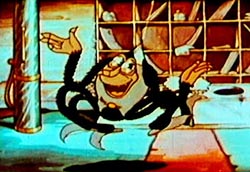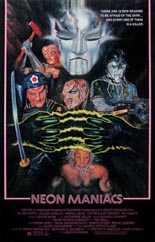
 One cannot credibly discuss Neon Maniacs without first asking what makes these maniacs neon at all, as the noble gas is not part of their outfits and they do not appear to own any. The only logical explanation I can think up is, “Because it was 1986, that’s why.”
One cannot credibly discuss Neon Maniacs without first asking what makes these maniacs neon at all, as the noble gas is not part of their outfits and they do not appear to own any. The only logical explanation I can think up is, “Because it was 1986, that’s why.”
Just accept it, since Joseph Mangine’s movie makes no effort to explain the creature cluster that comes to life after their trading cards are discovered in a steer’s skull beneath the Golden Gate Bridge and then bled upon. Or something like that. It’s not clear, nor does it need to be. The flick is all the more enjoyable in its absolute absence of backstory.
Heck, although great pains were undertaken to give each of its dozen monsters an individual identity, neither Mangine nor screenwriter Mark Patrick Carducci (Pumpkinhead) bothered to name them; only by reading the end credits or viewing the trailer do you learn they even have monikers. They’re more labels, really, what with the likes of Axe, Mohawk, Samurai, Ape and Decapitator, and I was hard-pressed after the fact to connect all the names with their corresponding ugly faces. I know them better as the one who looks like Maniac Cop, like Ali Gator from The Garbage Pail Kids Movie, like The Toxic Avenger, like a Blue Man Group member after a vehicular mishap, like My First Cenobite, like Ruth Buzzi with a crossbow, and so on.
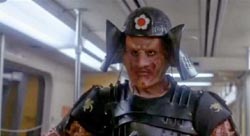 Anyway, they lay waste to a van full of high schoolers hanging out under the San Fran landmark for a night of football, firecrackers and fellatio. Only the sweater-wearing, birthday-girl virgin Natalie (Basic Instinct’s Leilani Sarelle, smoking-hot even with her ’80s Big Hair) survives the bloodletting — a pretty sweet present, if you ask me — but the cops write off her in-shock babbling as a teenage prank, despite all her missing friends. Suspended from school as a result, Natalie continues to be pursued by the demons, but finds an ally — and a fresh new beau — in a grocery delivery boy (Clyde Hayes, Friday the 13th: The Final Chapter) her pals dismissively referred to as “pasta breath” and “baloney boy.” (Take their gruesome deaths as karmic payback, if you prefer.)
Anyway, they lay waste to a van full of high schoolers hanging out under the San Fran landmark for a night of football, firecrackers and fellatio. Only the sweater-wearing, birthday-girl virgin Natalie (Basic Instinct’s Leilani Sarelle, smoking-hot even with her ’80s Big Hair) survives the bloodletting — a pretty sweet present, if you ask me — but the cops write off her in-shock babbling as a teenage prank, despite all her missing friends. Suspended from school as a result, Natalie continues to be pursued by the demons, but finds an ally — and a fresh new beau — in a grocery delivery boy (Clyde Hayes, Friday the 13th: The Final Chapter) her pals dismissively referred to as “pasta breath” and “baloney boy.” (Take their gruesome deaths as karmic payback, if you prefer.)
Not to spoil anything — because there is nothing to spoil — but the kids’ final showdown with the Neon Maniacs ends at a battle of the bands, where the audience is equipped with squirt guns because of this exchange slightly earlier:
“Look, what I’m saying is the only defense against these things is water. Just plain, old water.”
“Water?”
“Water.”
Water! (And a decade and a half before M. Night Shyamalan lazily used it!) Meanwhile, Mangine (whose only other directorial credit was Smoke and Flesh, a 1968 tab of hippiesploitation) threatens to kill his own viewers by subjecting their ears to a score of smooth jazz. Seriously, it’s so sax-drippy-dippy that you half-expect to see Dustin Hoffman shoving a mime. But other than that, Mrs. Lincoln, Neon Maniacs is nothing but fun, as cheesy as it is earnest, as earnest as it senseless. —Rod Lott


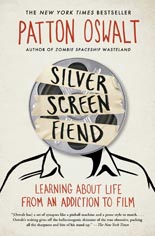
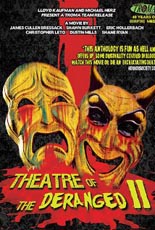

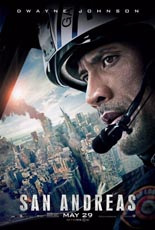
 When Dwayne Johnson (né The Rock) is introduced to
When Dwayne Johnson (né The Rock) is introduced to 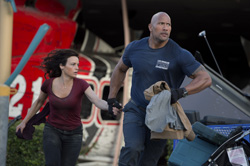
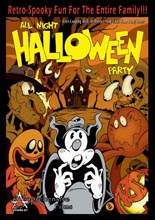
 What better time than the devil’s birthday to show your kids how racist cartoons used to be? The
What better time than the devil’s birthday to show your kids how racist cartoons used to be? The 